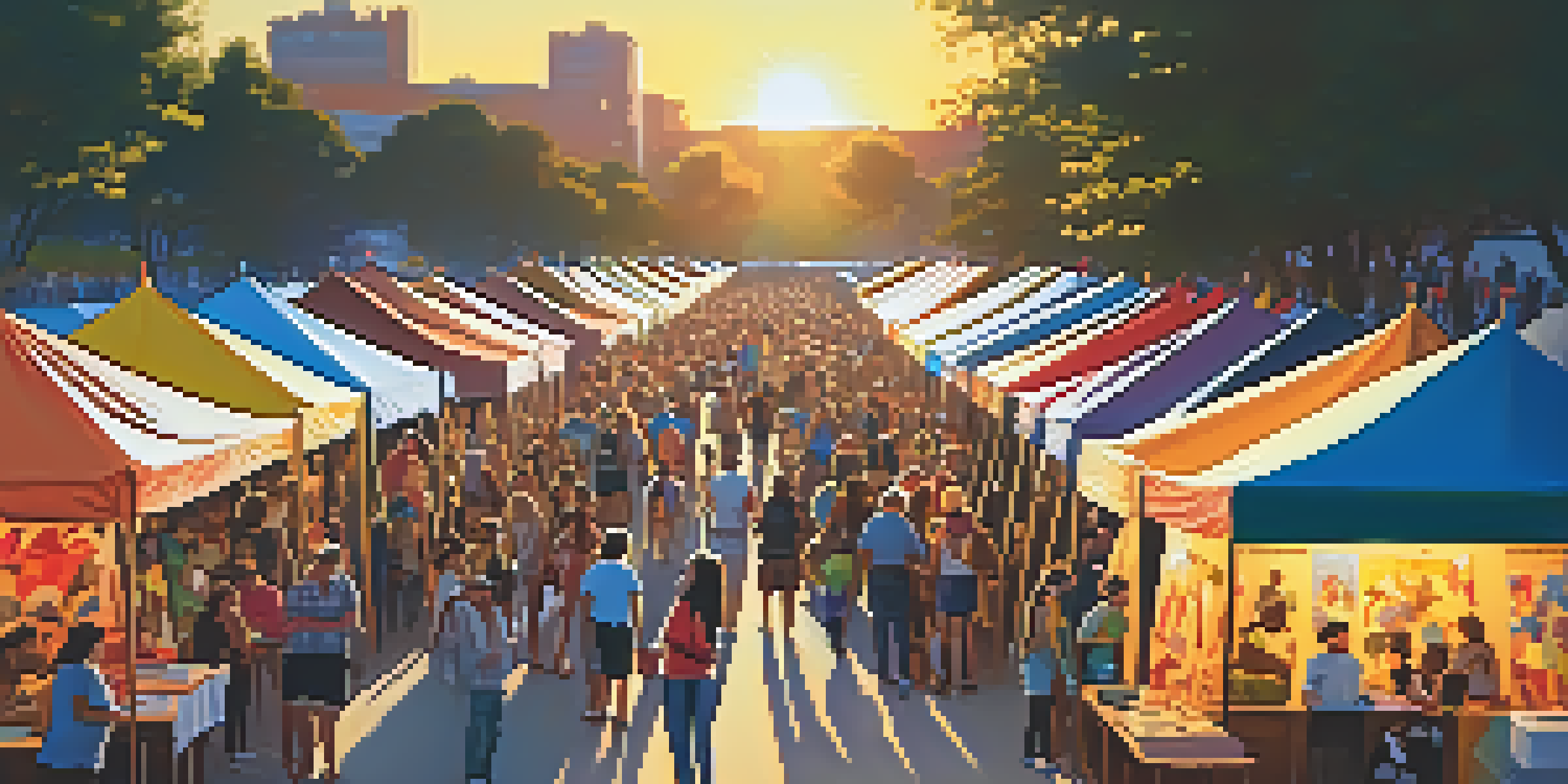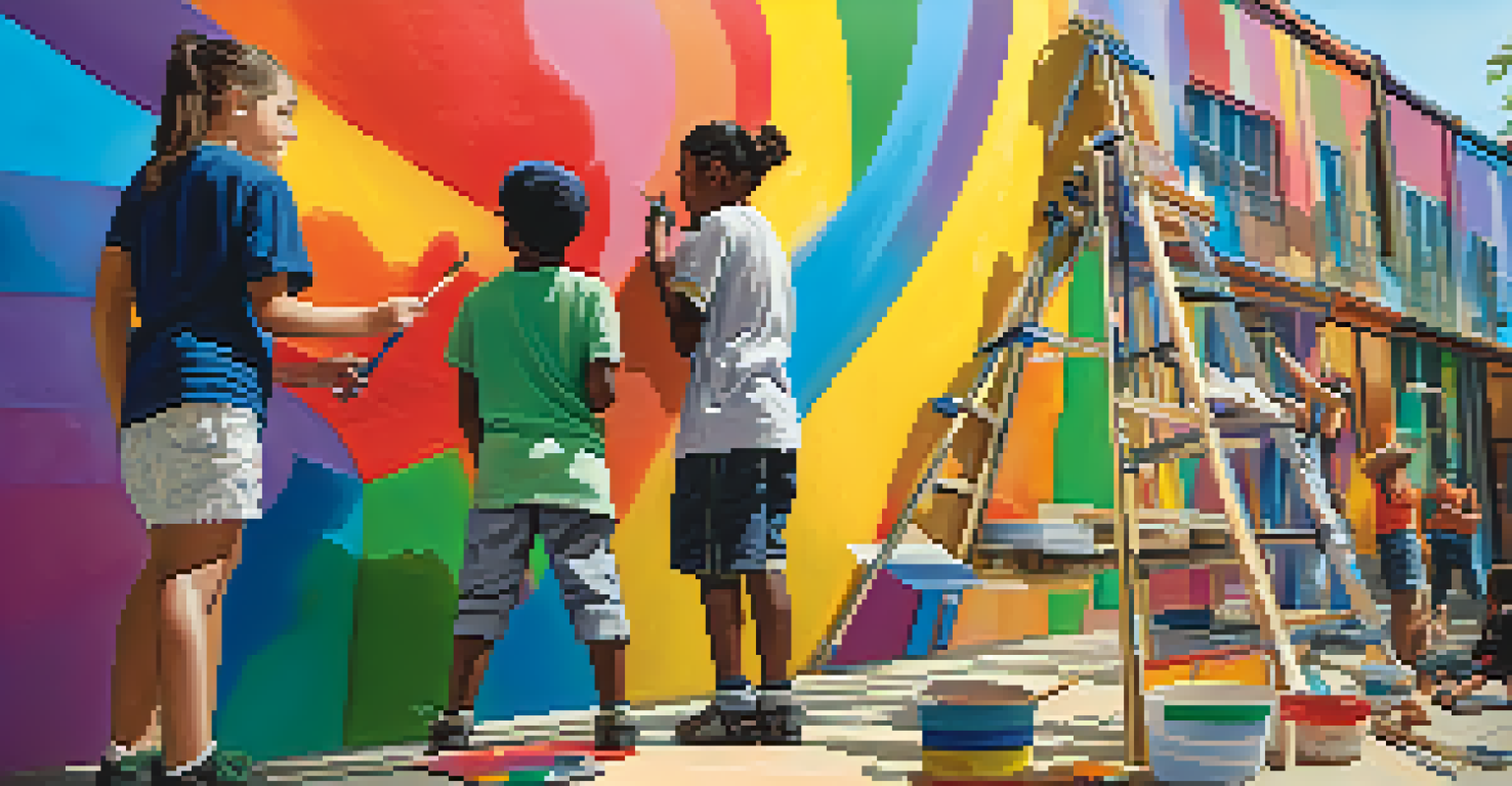Art Festivals: Celebrating Community Through Public Art

Understanding the Importance of Art Festivals
Art festivals serve as vibrant hubs where creativity and community converge. They provide a platform for artists to showcase their talents, while also engaging the public in the creative process. Beyond mere entertainment, these festivals play a crucial role in enhancing cultural identity and fostering local pride.
Art is not what you see, but what you make others see.
Consider a local art festival where neighborhood artists come together to display their work. This not only supports the artists but also creates an opportunity for attendees to connect with the cultural fabric of their community. The shared experience of appreciating art can foster conversations, friendships, and a deeper understanding of one another.
Moreover, art festivals often feature workshops and interactive installations that invite community participation. These elements encourage individuals to express themselves creatively, breaking down barriers and building a sense of belonging within the community.
The Role of Public Art in Community Identity
Public art can transform ordinary spaces into extraordinary experiences, serving as a visual representation of a community's identity. Murals, sculptures, and installations found in public spaces reflect the values, history, and aspirations of the community they inhabit. They can evoke emotions and inspire dialogue among residents and visitors alike.

For example, a mural depicting local history can spark curiosity and pride in community members, encouraging them to learn more about their heritage. Public art becomes a storyteller, weaving narratives that connect people to their surroundings and to each other.
Art Festivals Build Community Pride
Art festivals create opportunities for local artists to showcase their work, fostering connections and enhancing cultural identity within communities.
As communities invest in public art, they cultivate an environment that celebrates diversity and creativity. This not only enhances the aesthetic appeal of neighborhoods but also attracts tourists and fosters economic growth through increased foot traffic and engagement.
Fostering Inclusivity Through Art Festivals
Art festivals can be powerful tools for inclusivity, bringing together diverse groups of people from various backgrounds. By providing a platform for underrepresented artists and voices, these festivals promote understanding and appreciation of different cultures. This inclusivity enriches the festival experience for everyone involved.
Public art is a reflection of the community's identity; it tells the stories we want to share and the values we hold dear.
Imagine a festival featuring artists from various cultural backgrounds, each sharing their unique perspectives through their art. Attendees are offered a glimpse into different traditions and stories, fostering empathy and connection. This shared experience not only broadens horizons but also nurtures community ties.
Furthermore, by offering free or low-cost events, art festivals can ensure that everyone has access to participate. This commitment to inclusivity strengthens community bonds and helps create a sense of belonging for all residents, regardless of their background.
Art Festivals as Economic Catalysts
Beyond their cultural significance, art festivals can also be significant economic catalysts for local communities. They attract visitors who spend money on food, beverages, accommodations, and local businesses, providing a boost to the economy. This influx of visitors can be a game-changer for small businesses and local artisans.
For instance, a well-publicized art festival can draw thousands of attendees, benefiting not just artists but also local shops and restaurants. This creates a ripple effect that stimulates job creation and fosters community growth. The economic impact can be substantial, making art festivals a win-win for everyone involved.
Public Art Reflects Community Values
Public art transforms spaces and serves as a visual representation of a community's identity, sparking dialogue and pride among residents.
Additionally, festivals often require local services, from catering to security, further integrating the arts into the local economy. As communities recognize this potential, they become more invested in supporting and promoting art festivals as a key part of their economic strategy.
Environmental Impact of Art Festivals
Art festivals can also play a pivotal role in raising awareness about environmental issues. Many festivals incorporate sustainable practices, from waste management to the use of eco-friendly materials. This commitment to sustainability not only minimizes the environmental footprint but also educates attendees about the importance of caring for our planet.
For example, a festival might feature art made from recycled materials, encouraging artists to think creatively about waste. This not only reduces pollution but also inspires attendees to reflect on their consumption habits. The integration of environmental themes into public art can spur conversations and actions that extend beyond the festival.
Moreover, by showcasing nature-inspired art, festivals can highlight the beauty of the natural world and the need for its preservation. This connection between art and environment fosters a sense of stewardship within the community and encourages collective efforts towards sustainability.
Engaging Youth Through Art Festivals
Art festivals are fantastic opportunities to engage the younger generation in the arts, nurturing future artists and art enthusiasts. Many festivals include activities specifically designed for children and teenagers, such as workshops, interactive installations, and performances. These experiences can ignite a passion for creativity in young minds.
Consider a hands-on mural painting project where kids can express themselves alongside professional artists. This not only teaches them valuable skills but also instills a sense of accomplishment and ownership in their work. By involving youth in the creative process, festivals help cultivate a love for the arts that can last a lifetime.
Art Festivals Drive Economic Growth
By attracting visitors and encouraging spending at local businesses, art festivals act as economic catalysts that benefit entire communities.
Moreover, the exposure to various art forms can broaden their horizons and encourage critical thinking. As young people engage with art and culture, they develop a deeper appreciation for diversity and creativity, which can positively impact their personal growth and community involvement.
The Future of Art Festivals in Community Development
As we look to the future, art festivals are poised to play an even more significant role in community development. By continually adapting to the needs of their communities, festivals can enhance their relevance and impact. This evolution can include incorporating technology, addressing social issues, and fostering greater participation.
For instance, the integration of virtual components can expand reach and accessibility, allowing those unable to attend in person to participate. This adaptation not only broadens the audience but also enriches the festival experience through diverse perspectives and interactions.

Ultimately, the future of art festivals lies in their ability to connect people, inspire creativity, and foster community spirit. As they continue to evolve, they will remain essential in shaping vibrant, inclusive, and engaged communities.